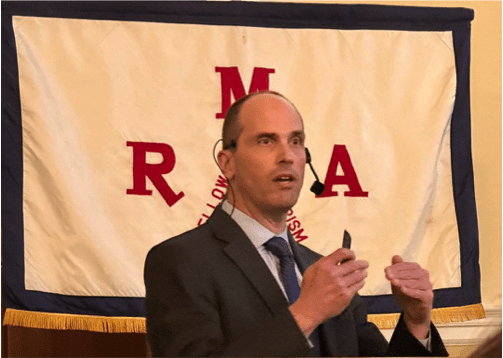

By Bob Shullman
At the Retired Men’s Association (RMA) meeting on March 15, Spike Lipschutz of the RMA introduced Dr. Alexander DelVecchio, a cardiologist at Greenwich Hospital who delivered a very informative presentation focused on heart health and two of the most common heart conditions: atrial fibrillation and cardiac arrhythmia. During his discussion he presented 33 slides that provided an informative overview of arrhythmia and medical issues such as how to recognize symptoms of arrhythmia and the treatments and interventions that are available to treat it. Dr. DelVecchio also focused on atrial fibrillation, a cardiac rhythmic disturbance, especially prominent in older adults. Its treatment often involves medications that have serious potential side effects, and options to treat it depend on many factors, particularly the prevention of life-altering disease if not treated effectively.
Following are very brief summaries of the doctor’s thoughts regarding heart health, arrhythmia and atrial fibrillation. Recounting his presentation in detail would take many pages and include medical terminology, but they can be viewed on the video of the presentation on the RMA website.
• HEART HEALTH. In this very brief portion of his presentation, the doctor reviewed how the heart functions using very clear visuals as he discussed the heart’s similarity to how an auto engine and auto transmission work together to power an automobile. He then focused on how EKG’s that are typically part of an annual physical exam are used by doctors to assess how well the heart is functioning and many times indicate that a person has arrhythmia.
• ARRHYTHMIA. What exactly is it? It is a condition in which the heart beats with an irregular or abnormal rhythm. The doctor then discussed the two types of arrhythmias: Brady arrhythmias when the heart beats too slowly and Tachy arrhythmias when the heart beats too fast.
• ATRIAL FIBRILLATION. What is it? It is the most commonly treated arrhythmia that is usually identified by an EKG. Symptoms that an individual may notice of having this condition that should lead them to see a doctor include: palpitations, shortness of breath, chest pain, dizziness and sometimes no symptoms. Why should an individual deal with these symptoms when they experience one or more of them? Atrial fibrillation many times is the forerunner of an individual then experiencing a stroke. The typical ways that are used to treat these conditions include: prescription drugs, electric cardioversion (shock therapy) and the implantation of a pacemaker. The doctor then briefly described how each of these potential treatments works.
Dr. DelVecchio then asked if there were any questions from the audience and, as expected, many hands went up. Those interested in the questions that were asked and the doctor’s responses are urged to go to the RMA website and click on the video of the discussion.
Dr. DelVecchio is a cardiology specialist and has been affiliated with Greenwich Hospital since 2004 and Yale New Haven Hospital since the two medical facilities entered into a partnership. He has extensive experience in heart conditions, cardiac electrical system procedures, and adult congenital heart conditions. He earned his medical degree from Albert Einstein College of Medicine in 1996, did his residency in internal medicine at Montefiore Medical Center from 1997-1999, and completed his training with two fellowships at Montefiore Medical Center, one in cardiovascular disease, 2000 – 2003, and one in cardiac electrophysiology, 2003 – 2004. He is board certified and has been selected one of the top doctors in the Metro Area since 2017 and accorded other honors.
To see the full presentation, go to https://greenwichrma.org, cursor to “Speakers” and click on “Speaker Videos.”
The RMA’s next presentation, ”Unicorns and Heroes: John D. Rockefeller, Jr. and Tapestries at The Met Cloisters”, will be given by C. Griffith Mann, Ph.D. The Unicorn Tapestries are among the most beautiful and complex works of art from the late Middle Ages that survive. Luxuriously woven in fine wool and silk with silver and gilded threads, the tapestries vividly depict scenes associated with a hunt for the elusive, magical unicorn. The Heroes Tapestries, representing the Hebrew heroes (Joshua and David), the Christian hero (King Arthur), and the pagan heroes (Alexander the Great and Julius Caesar), are thought to have been made around 1400. Once part of a larger ensemble featuring Nine Heroes, these remarkable tapestries are among the earliest large-scale tapestries to survive from a moment when these ensembles were part of princely collections and are currently being conserved at the Met.
Dr. Mann was appointed The Metropolitan Museum of Art’s Michel David-Weill curator in charge of the Department of Medieval Art and The Cloisters in 2013. In this role, he is responsible for the medieval collections and curatorial staff in the Met’s main building and for directing the staff and operations of The Cloisters, the branch of the Metropolitan Museum dedicated to the art and architecture of medieval Europe. Dr. Mann received his B.A. in art history and history from Williams College and his Ph.D. in medieval art from The Johns Hopkins University. A specialist in the arts of late medieval Italy, he has published on civic patronage, painting, and devotion in Tuscany.
Griff is a graduate of Greenwich High School, class of 1987.
This informative presentation will occur on Wednesday, March 29, at 11:00 a.m. at the First Presbyterian Church in Greenwich as well as on webinar at: https://bit.ly/30lBj21.
RMA speaker presentations are presented as a community service at no cost to in-person or Zoom attendees, regardless of gender. The RMA does request that all eligible individuals consider becoming a member of our great organization, and thereby enjoy all the available fellowship, volunteer and community service opportunities that the RMA offers to its members. For further information, visit https://greenwichrma.org or contact Joe Mancinelli (mailto:jlmanc@optonline.net) or Peter Stern (mailto:members@greenwichrma.org).
Note: The views expressed in these RMA presentations are those of the speakers. They are not intended to represent the views of the RMA or its members.




